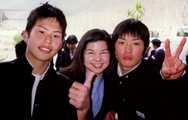
“JET Program Description - What is JET anyway?”
by Joelle Williams, ’97
The Japan Exchange and Teaching Program was established in 1987 to promote foreign language education and international exchange and understanding throughout Japan in cooperation with the Program's 34 participating countries. Conducted by local governments, the Ministry of Foreign Affairs, the Ministry of Education, and the Ministry of Home Affairs and the Council of Local Authorities for International Relations (CLAIR), the JET Program currently has a total of 5,700 participants. Program participants work as either Assistant Language Teachers (ALTs) in junior and senior high school or for local governments as Coordinators for International Relations (CIRs). In addition, a small number of participants act as Sports Exchange Advisors (SEA's). College and University graduates may apply for the JET program through a written application form, from which then a limited number are selected by the Ministry of Foreign Affairs to advance to the interview process.
The joys and challenges of life as an ALT
 To share all the experiences I've had while living and teaching in Japan would take more pages than I can begin to count. To put it simply, I love it here. At this point in my life, choosing the JET program was the best thing I could have done after graduating from Kenyon . Coming to Japan as an Assistant Language Teacher (ALT) has led to the most wonderful, challenging, frustrating, joyful, and inspiring moments I have ever experienced. There have been a few rare times when I wish I could hop on the next flight home, but more often I picture myself staying in Japan years beyond my JET contract. Sometimes I'm not sure if that is due more to the fact that I am completely comfortable living in Japan and simply enjoy spending time in this country, or whether it's due to the satisfaction I find in my work. Either way, I have JET to thanks for helping me find my way back to Japan.
To share all the experiences I've had while living and teaching in Japan would take more pages than I can begin to count. To put it simply, I love it here. At this point in my life, choosing the JET program was the best thing I could have done after graduating from Kenyon . Coming to Japan as an Assistant Language Teacher (ALT) has led to the most wonderful, challenging, frustrating, joyful, and inspiring moments I have ever experienced. There have been a few rare times when I wish I could hop on the next flight home, but more often I picture myself staying in Japan years beyond my JET contract. Sometimes I'm not sure if that is due more to the fact that I am completely comfortable living in Japan and simply enjoy spending time in this country, or whether it's due to the satisfaction I find in my work. Either way, I have JET to thanks for helping me find my way back to Japan.
Living on my own for the first time has presented its own challenges, but it has enabled me to learn about myself as well as to appreciate the many simple joys that life in rural Japan has to offer. I have met numerous members of my local community whose warmth and friendliness never seem to cease; they surprise me on many occasions with their expressions of generosity: my supervisor padding around in slippered feet while cooking me udon soup when I was sick; my neighbor who welcomes me home from school and brings me fresh watermelon; the kind lady who rescues me with her jumper cables when my car battery has died. These are just a few examples of the kindness I encounter everyday in my little town of Kaibara, Japan.
I think that so much of what each participant gets out of JET depends on where you are placed and how much you make an effort to actively involve yourself in the community. I often think how fortunate I am to have been assigned to the Board of Education that I work for. My supervisors are wonderfully helpful and understanding and the small town that I know call home is rural, but not without all necessities.* Outside of my regular teaching job, I tutor elementary school students, teach adults, study Japanese, take dance classes and play taiko (traditional Japanese drums). *Note: Do not expect to come to Japan on JET for an adventure in the big cities of Tokyo and Osaka. Although you have space on your application to express location preferences, the majority of the program participants are located in rural areas.
 In my case, there are Assistant Language Teachers (ATLs) for the country's seven junior high schools. This gives me the opportunity to work in various teaching environments as I teach at one school at a time, rotating between them at two- to four-month intervals. Having never formally taught before, I was a little apprehensive at first, but have since learned that patience, a smile, and enthusiasm have helped me more than a degree in education could have. JET encourages the "team-teaching" method, by which the ALT works side by side with a Japanese teacher of English (JTE). This can be frustrating at times, depending on your JTE's level of English comprehension and willingness to cooperate, but team-teaching can bring rewarding and memorable moments to the classroom as well. I have been fortunate enough to work with several great teachers who were very good about joint lesson planning and taking advantage of having a native English speaker at their disposal. In addition, being able to communicate in Japanese has been to my advantage on the job and in everyday life situations.
In my case, there are Assistant Language Teachers (ATLs) for the country's seven junior high schools. This gives me the opportunity to work in various teaching environments as I teach at one school at a time, rotating between them at two- to four-month intervals. Having never formally taught before, I was a little apprehensive at first, but have since learned that patience, a smile, and enthusiasm have helped me more than a degree in education could have. JET encourages the "team-teaching" method, by which the ALT works side by side with a Japanese teacher of English (JTE). This can be frustrating at times, depending on your JTE's level of English comprehension and willingness to cooperate, but team-teaching can bring rewarding and memorable moments to the classroom as well. I have been fortunate enough to work with several great teachers who were very good about joint lesson planning and taking advantage of having a native English speaker at their disposal. In addition, being able to communicate in Japanese has been to my advantage on the job and in everyday life situations.
My "kids," as I like to call my students, are so adorable and fun to work with. For many students, the rural ALT is the first foreigner they meet, which puts the ALT in a special position. The first year of junior high school is traditionally the first time students study a foreign language so they are quite excited about meeting their ALT. Although their command of the English language is quite limited at this age, my students and I are usually able to communicate through a strange mixture of broken English and Japanese, smiles, gestures, and guessing games. I have found that you have to work extremely hard sometimes just to get the students' voices above a whisper in class, but if you take the time to interact with them outside of class , you will be rewarded. If I've had a rough day at school, it often takes just one child's friendly wave or a group of giggling girls running down the hallway towards me squealing, "Sensei, Sensei!" (Teacher, Teacher) to make me smile again.
If you have any interest in Japan, working with children, promoting international understanding, or experiencing the culture and lifestyle of another society, I highly recommend JET. Please feel free to contact me, Joelle Williams, with questions regarding the program, the application process, or other concerns about life in Japan.
Address:
Joelle T. Williams, Assistant Language Teacher
Hiami-gun Board of Education
271-4 Takaso H, Kominami
Kaibara-cho, Hikami-gun
Hyogo-ken, 669-3308 JAPAN
 Back to Teach in Asia
Back to Teach in Asia
Comments to: Rita S. Kipp
Last Edited: 11/23/98
 Back to Kenyon
Back to Kenyon  Asian Studies Homepage
Asian Studies Homepage



 Back to Kenyon
Back to Kenyon  Asian Studies Homepage
Asian Studies Homepage